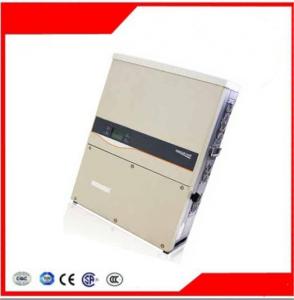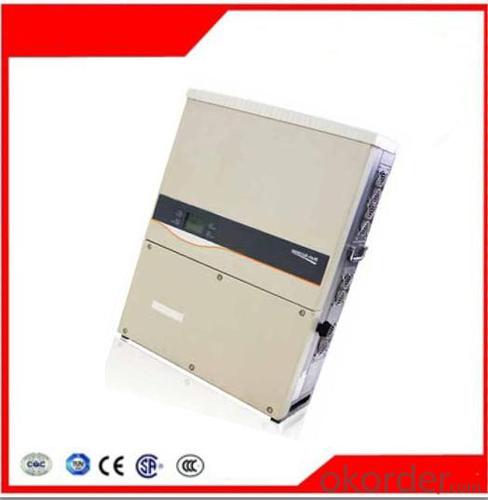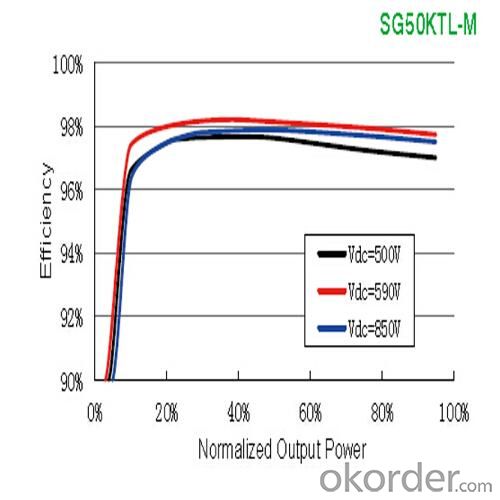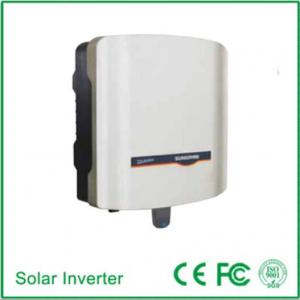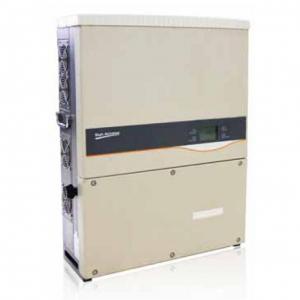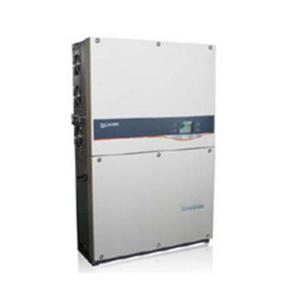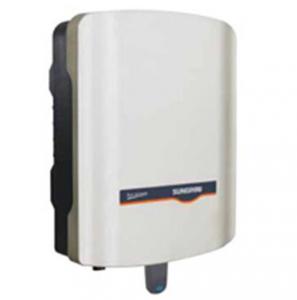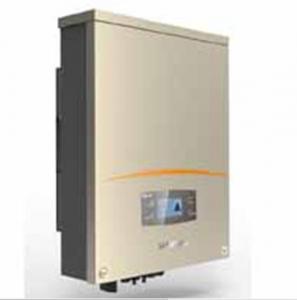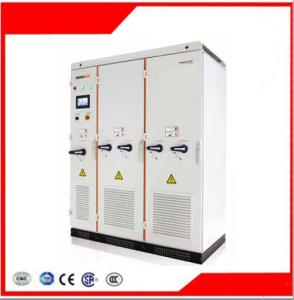Solar Inverter Panel Photovoltaic Grid-Connected Inverter SG50KTL-M
- Loading Port:
- China Main Port
- Payment Terms:
- TT or LC
- Min Order Qty:
- 500000 unit
- Supply Capability:
- 3000000 unit/month
OKorder Service Pledge
OKorder Financial Service
You Might Also Like
1. Structure of Photovoltaic Grid-Connected Inverter SG50KTL-M Description
A solar inverter, or PV inverter, or Solar converter, converts the variable direct current (DC) output of a photovoltaic (PV) solar panel into
autility frequency alternating current (AC) that can be fed into a commercial electrical grid or used by a local, off-grid electrical network.
It is acritical BOS–component in a photovoltaic system, allowing the use of ordinary AC-powered equipment. Solar inverters have
special functions adapted for use with photovoltaic arrays, including maximum power point tracking and anti-islanding protection.
Suitable for 50Hz/60Hz grid, could be used in Asia, Africa and Europe. Available for hand installation, no need for lifting machinery
assistance.
2. Main Features of the Photovoltaic Grid-Connected Inverter SG50KTL-M
• High flexibility for complex configurations due to 4 MPP trackers and a wide input voltage range
• High yields due to efficiency up to 98.9% and EU efficiency of 98.5%
• Output power up to 55kVA / 55kW(SG50KTL-M) and 66kVA / 66kW(SG60KTL-M) at power factor of 1
• Integrated combiner box: 12 x MC4 connector pairs with DC string fuses, Type II overvoltage protection and DC switch, more safety and lower the system cost
• Active power continuously adjustable (0~100%)
• Fulfill a variety of reactive power adjustment requirments with power factor 0.8overexited ~0.8 underexited
• Integrated LVRT and HVRT function
• Includes RS-485 interface, compatible with all common monitoring systems
• Product certification: TÜV, CE, G59/3, BDEW, CGC and GB-T19964
• Manufacturer certification: ISO 9001, ISO 14001, OHSAS 18000
3. Photovoltaic Grid-Connected Inverter SG40KTL Images
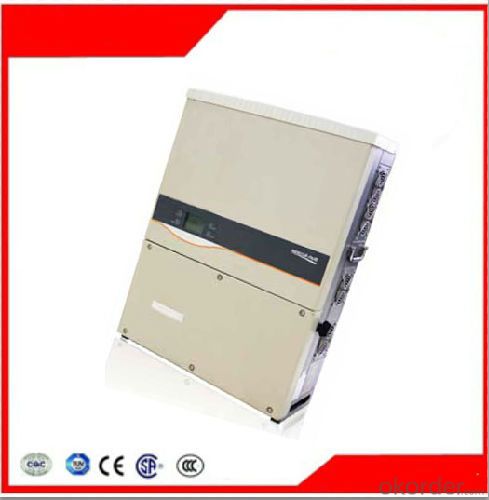
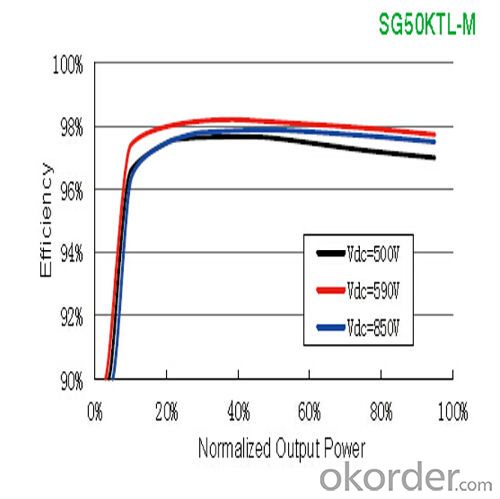

4. Photovoltaic Grid-Connected Inverter SG50KTL-M Specification
Side Data | |
Max. PV input power | 56200W |
Max. PV input voltage | 1000V |
Startup voltage | 300V |
Nominal input voltage | 590V |
MPP voltage range | 300~950V |
MPP voltage range for nominal power | 500~850V |
No. of MPPTs | 4 |
Max. number of PV strings per MPPT | 3 |
Max. PV input current | 104A(26A/26A/26A/26A) |
Max. current for input connector | 12A |
Output Side Data | |
Nominal AC output power | 50000W |
Max AC output power(PF=1) | 55000W |
Max. AC output apparent power | 55000VA |
Max. AC output current | 80A |
Nominal AC voltage | 3/N/PE, 230/400Vac |
AC voltage range | 310~480Vac |
Nominal grid frequency | 50Hz/60Hz |
Grid frequency range | 45~55Hz /55~ 65Hz |
THD | < 3 % (Nominal power) |
DC current injection | <0.5 %In |
Power factor | >0.99@default value at nominal power |
(adj. 0.8overexcited ~0.8underexited) | |
Protection | |
Anti-islanding protection | Yes |
LVRT | Yes |
DC reverse connection protection | Yes |
AC short circuit protection | Yes |
Leakage current protection | Yes |
DC switch | Yes |
DC fuse | Yes |
Overvoltage protection | DC Type II DIN rail surge arrester(40kA) |
System Data | |
Max. efficiency | 98.90% |
Max. European efficiency | 98.50% |
Isolation method | Transformerless |
Ingress protection rating | IP65 |
Night power consumption | <1W |
Operating ambient temperature range | -25~60℃(>50℃ derating) |
Allowable relative humidity range | 0~100% |
Cooling method | Smart forced air cooling |
Max. operating altitude | 4000m (>3000m derating) |
Display | Graphic LCD |
Communication | RS485 |
DC connection type | MC4 |
AC connection type | Screw Clamp terminal |
Certification | VDE0126-1-1,EN62109-1,EN62109-2,G59/3, |
BDEW,GB/T 19964, GB/T 29319 | |
Mechanical Data | |
Dimensions(W×H×D) | 665 * 906 * 256 mm |
Mounting method | Wall bracket |
Weight | 70kg |
5. FAQ of Photovoltaic Grid-Connected Inverter SG50KTL-M
Q1. What is the difference between inverter and solar inverter?
A1. Inverter only has AC inpput, but solar inverter both connect to AC input and solar panel, it saves more power.
Q2. What is the difference between MPPT&PWM?
A2. MPPT has higher efficiency, it can track the max power point and won't waste energy.
- Q: Can a solar inverter be used in conjunction with a smart home system?
- Yes, a solar inverter can be used in conjunction with a smart home system. In fact, many modern solar inverters are designed to integrate seamlessly with smart home technologies. This allows homeowners to monitor and control their solar energy production, consumption, and other connected devices through a centralized smart home system or smartphone app.
- Q: How does a solar inverter handle anti-islanding protection?
- A solar inverter handles anti-islanding protection by constantly monitoring the grid voltage. If the grid goes down or voltage drops below a certain threshold, the inverter automatically disconnects from the grid to prevent feeding power back into the grid during an outage. This ensures the safety of utility workers and prevents damage to the grid.
- Q: Can a solar inverter be installed in a residential area?
- Yes, a solar inverter can be installed in a residential area. In fact, residential areas are common locations for solar installations, including the installation of solar inverters. These inverters are responsible for converting the direct current (DC) electricity generated by solar panels into alternating current (AC) electricity that can be used by household appliances and fed back into the electrical grid. Installing a solar inverter in a residential area allows homeowners to harness the power of solar energy and reduce their reliance on traditional electricity sources.
- Q: What is the role of a solar inverter in reactive power compensation?
- The role of a solar inverter in reactive power compensation is to monitor and regulate the reactive power flow in the electrical system. It helps maintain a power factor closer to unity by injecting or absorbing reactive power as needed. This is crucial for improving the overall efficiency and stability of the grid, as well as reducing voltage fluctuations and line losses.
- Q: Can a solar inverter be used with both AC and DC power sources?
- No, a solar inverter is designed to convert DC power generated by solar panels into usable AC power for household or grid consumption. It cannot be used directly with DC power sources.
- Q: Can a solar inverter be used with a solar-powered CCTV system?
- Yes, a solar inverter can be used with a solar-powered CCTV system. A solar inverter is responsible for converting the direct current (DC) produced by solar panels into alternating current (AC) that can be used to power electrical devices. In the case of a solar-powered CCTV system, the solar inverter can convert the DC power generated by the solar panels into the AC power required to run the CCTV system, ensuring it functions properly.
- Q: What is the role of a solar inverter in a residential system?
- The role of a solar inverter in a residential system is to convert the direct current (DC) electricity produced by the solar panels into alternating current (AC) electricity that can be used to power household appliances and be fed into the electrical grid. It ensures efficient use of solar energy and enables easy integration of solar power into the existing electrical infrastructure of a home.
- Q: What is the role of a solar inverter in a net metering system?
- The role of a solar inverter in a net metering system is to convert the direct current (DC) electricity generated by the solar panels into alternating current (AC) electricity, which is compatible with the electrical grid. The inverter also synchronizes the solar system with the grid, ensuring that excess electricity generated by the solar panels is fed back into the grid, allowing for net metering and the possibility of earning credits for the surplus energy generated.
- Q: Can a solar inverter be used with a solar-powered refrigerator?
- Yes, a solar inverter can be used with a solar-powered refrigerator. The solar inverter is responsible for converting the direct current (DC) electricity generated by the solar panels into alternating current (AC) electricity, which is required to power the refrigerator. By using a solar inverter, the solar-powered refrigerator can operate efficiently and effectively by utilizing the solar energy collected from the panels.
- Q: Can a solar inverter be used with a solar-powered cooling system?
- Yes, a solar inverter can be used with a solar-powered cooling system. The solar inverter is responsible for converting the direct current (DC) power generated by the solar panels into alternating current (AC) power, which is required to operate the cooling system. By connecting the solar panels to the inverter, the generated solar energy can be efficiently utilized to power the cooling system, making it a sustainable and eco-friendly solution.
Send your message to us
Solar Inverter Panel Photovoltaic Grid-Connected Inverter SG50KTL-M
- Loading Port:
- China Main Port
- Payment Terms:
- TT or LC
- Min Order Qty:
- 500000 unit
- Supply Capability:
- 3000000 unit/month
OKorder Service Pledge
OKorder Financial Service
Similar products
Hot products
Hot Searches
Related keywords
